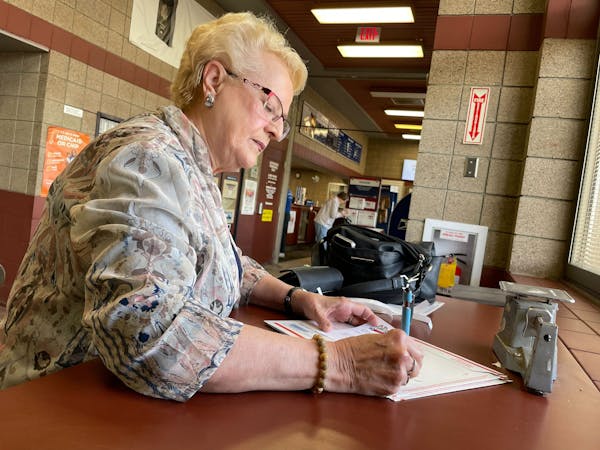On an otherwise ordinary day a couple of years ago, artist Gudrun Lock walked her dog along the southern edge of Shoreham Yards, a 230-acre train and trucking facility that borders the northeast Minneapolis neighborhood where she lives.
"This should be a forest," she thought as she looked at the seven-block strip, home to a rail yard since the 1880s. Lock found herself musing about "a woman who is a descendant of druids, and is a botanist, and talks about the aerosols in trees and how they alter our brain energy, and how mini-forests can be planted around the world."
That curious streak imbues her installation "The Nature of Shoreham Yards," now on view at the University of Minnesota's Weisman Art Museum. Part research-in-progress, part collective exploration, the exhibit houses a variety of random elements from the buffer area surrounding Shoreham Yards.
Bird-survey checklists, which collaborators filled out during a visit to the site. Aerial photos of the space. A taxidermied beaver and two ducks in a glass case. Post-its with notes like "Why does the DNR characterize black locust as a noxious weed?" And dozens of shredded, decomposing men's Fruit of the Loom underwear, hanging in bags on the walls.
We caught up with Lock, who is interested in marginalized places and bodies — both human and non-human — to learn more about the site and her project. This interview has been edited for clarity.
Q: What fascinates you about this buffer zone that you say is "both polluted and full of life"?
A: This is what happens in these types of marginal places — things that can't live or exist elsewhere. Homeless people, garbage, plants and animals that maybe we don't allow. Ground dwelling species. I came face-to-face with a coyote, fox, deer, all using the northern section of the site.
The reality of railroads is that they cross all kinds of territory. Pre-European prairie land, I have heard, can still be found next to train tracks. It becomes corridors for animals. Tons of birds use that site. The northern part is an extension of Columbia Golf Course. It was called Sandy Lake and was filled with debris when the city was digging out Lake Calhoun. Then it became a golf course.
Q: How are sites like this "rich for re-imagining our relationship to colonialist expansion, historical pollution, contemporary consumption and wildness," as you describe it?
A: It is not all that uncommon to find dump sites or marginal places or Army training bases to be full of diversity. It is a combination of being left alone and the disturbance that has been created, which for good and bad produces different effects.
The language around these spaces is "degraded," "disturbed," "highly disturbed," "poor soil," but in fact 80 different bird species use the site. There are all types of plants — invasive and native. I think when we start looking at these places with different eyes, we can see there is all this kind of life going on here that would benefit from being acknowledged, supported and allowed to survive.
Q: What's up with the 100 pairs of decomposing men's underpants?
A: The "Soil Your Undies Challenge" was created by Oregon farmers as a playful way to show that the soil is alive even in places that seem poor or degraded. You plant the underpants, and the elastic doesn't disintegrate so you can find them again. There are these amazing photos of big dudes with extra-large underpants in their hands and big smiles on their faces.
[When we planted underpants in the buffer zone], I assumed that nothing would happen in areas that seem the most degraded, where it looks like sand and rubble and concrete. But the underpants in those places, left exposed to sunlight, decomposed the quickest, even during our extreme drought. We had rain, and I went out with friends and pulled underwear up, and the ones that we planted in soil that had the most organic matter and seemed the richest — those were almost whole.
The Nature of Shoreham Yards
When: 10 a.m.-8 p.m. Wed., 10-5 Thu.-Fri., 11-5 Sat.-Sun. through May 15.
Where: Weisman Art Museum, 333 East River Pkwy., Mpls.
Admission: Free. Masks and proof of vaccination required.
Info: wam.umn.edu
Sign up for Star Tribune newsletters

Drone footage shows Ukrainian village battered to ruins as residents flee Russian advance
In heated western Minn. GOP congressional primary, outsiders challenging incumbent

